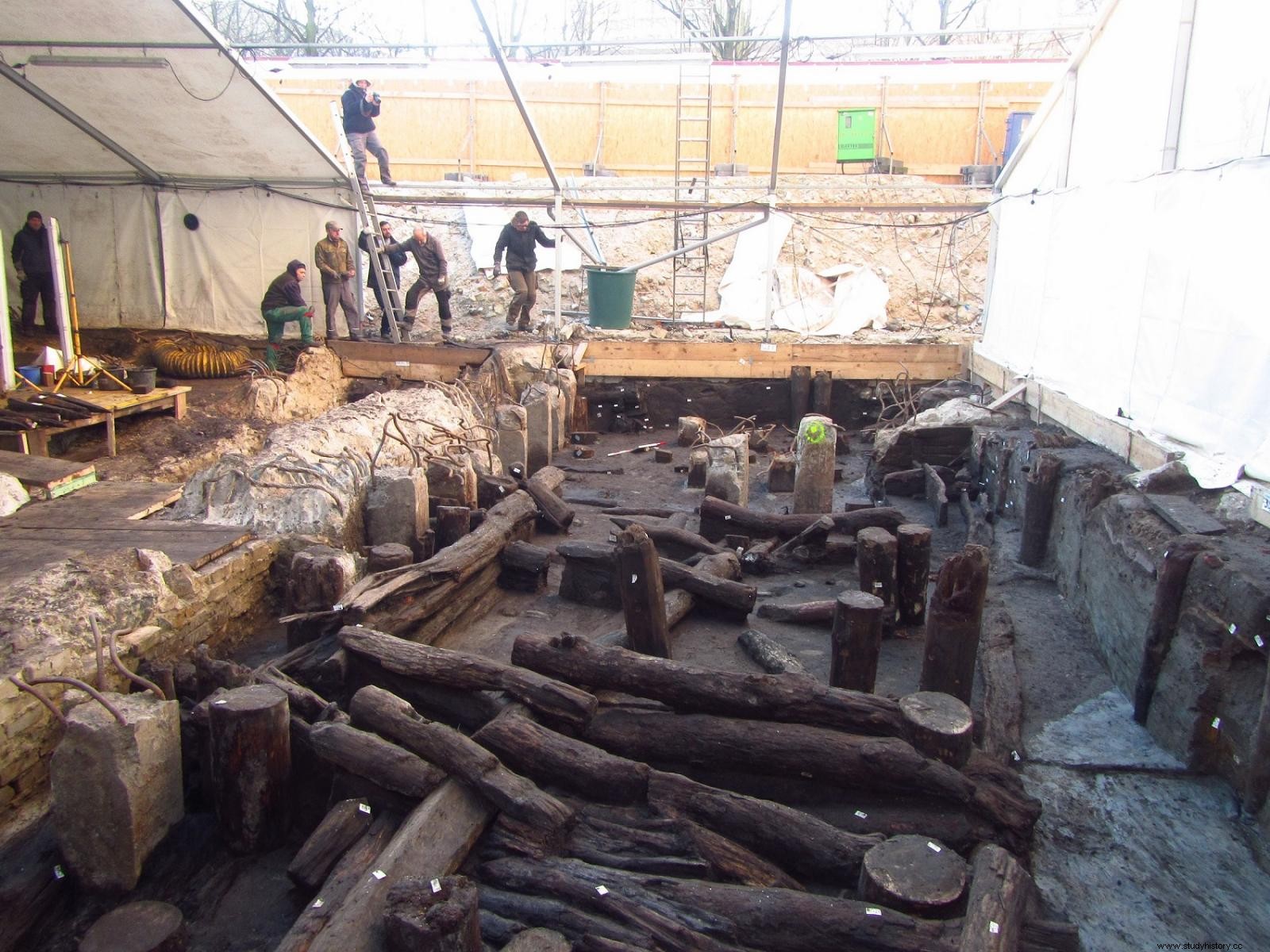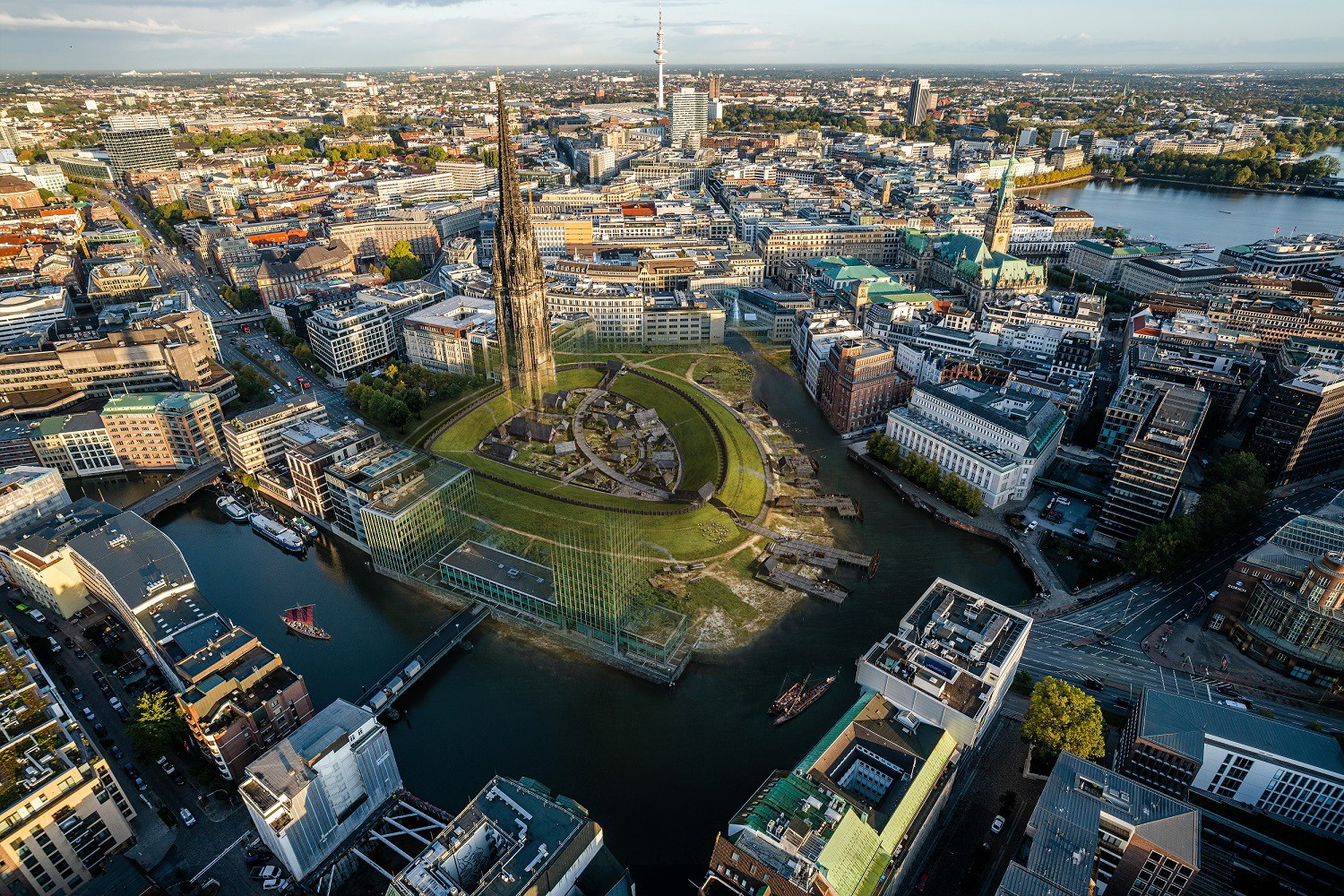Archaeologists in Hamburg (Germany) have recently found timber from the old ramparts of a Saxon castle, which in the 11th century was the largest in northern Germany. They reconstruct in an exhibition the various fortifications erected during the "dark ages" of the city.

Built just a thousand years ago, the new castle (Neue Burg) is the original heart on which the city of Hamburg will develop from the 12th century.
Embedded in the meanders of the Elbe and the Alster, Hamburg is, after Berlin, the second largest city in Germany, and yet an important part of its history remained unknown until recently. Over the past twenty years, however, archaeologists have made spectacular discoveries that now allow them to rewrite Hamburg's past in the "dark ages", before it became a flourishing Hanseatic city.
The fortresses of Hamburg in the time of the dark ages
The results of the excavations carried out over the past two decades by the archaeologists of the city of Hamburg not only make it possible to redraw the contours of its historic center, but also to question the written sources on which historians have based themselves to know the period. known as the "dark ages". Between the 8th and the end of the 12th century, no visible trace remains, although the texts mention several fortified residences, intended to protect the site, which served from the beginning of the Middle Ages as a transit zone for goods from Northern Europe. By finding their remains, the researchers have therefore succeeded in filling in the gaps in the medieval past of the city and in reconstructing the various establishments which formed its original nucleus. The results of their research are presented as part of an exhibition at the Archaeological Museum of Hamburg.
The first Saxon settlement on the site of Hammaburg
The first attested settlement at the current location of Hamburg was founded by the Germanic tribe of the Late Saxons, shortly before the reign of Charlemagne. Its Saxon designation, Hammaburg ("castle in the moist plain (or bay)"), already qualifies it as a castle. However, it is only a small circular enclosure measuring about 65 meters in diameter, protected by a wooden palisade and a defensive ditch, which is the only element of which archaeologists have found traces. At the heart of this enclosure are only a few houses, including that of the chief, because the majority of the some 200 inhabitants of the colony live outside the ramparts, in wooden huts made up of half-timberings covered with clay or in houses- pits.
Hammaburg at the time of Christianization
The first written mention of Hammaburg dates from 834, when the French monk Anschaire (801-865) went there on the orders of Louis the Pious (778-840), son of Charlemagne, who succeeded him as Western Emperor. Anschaire has the dual mission of converting the Saxons and advancing Christianization towards Scandinavia, with the aim of extending the power and influence of the Franks to the north. If the colony was chosen as a base, it is because of its favorable geographical location, on the banks of the Elbe and accessible by sea. This decision will seal its destiny, since it will become one Empire border secure points.
Embedded in the meanders of the Elbe and the Alster, Hamburg is, after Berlin, the second largest city in Germany, and yet an important part of its history remained unknown until recently. Over the past twenty years, however, archaeologists have made spectacular discoveries that now allow them to rewrite Hamburg's past in the "dark ages", before it became a flourishing Hanseatic city.
The fortresses of Hamburg in the time of the dark ages
The results of the excavations carried out over the past two decades by the archaeologists of the city of Hamburg not only make it possible to redraw the contours of its historic center, but also to question the written sources on which historians have based themselves to know the period. known as the "dark ages". Between the 8th and the end of the 12th century, no visible trace remains, although the texts mention several fortified residences, intended to protect the site, which served from the beginning of the Middle Ages as a transit zone for goods from Northern Europe. By finding their remains, the researchers have therefore succeeded in filling in the gaps in the medieval past of the city and in reconstructing the various establishments which formed its original nucleus. The results of their research are presented as part of an exhibition at the Archaeological Museum of Hamburg.
The first Saxon settlement on the site of Hammaburg
The first attested settlement at the current location of Hamburg was founded by the Germanic tribe of the Late Saxons, shortly before the reign of Charlemagne. Its Saxon designation, Hammaburg ("castle in the moist plain (or bay)"), already qualifies it as a castle. However, it is only a small circular enclosure measuring about 65 meters in diameter, protected by a wooden palisade and a defensive ditch, which is the only element of which archaeologists have found traces. At the heart of this enclosure are only a few houses, including that of the chief, because the majority of the some 200 inhabitants of the colony live outside the ramparts, in wooden huts made up of half-timberings covered with clay or in houses- pits.
Hammaburg at the time of Christianization
The first written mention of Hammaburg dates from 834, when the French monk Anschaire (801-865) went there on the orders of Louis the Pious (778-840), son of Charlemagne, who succeeded him as Western Emperor. Anschaire has the dual mission of converting the Saxons and advancing Christianization towards Scandinavia, with the aim of extending the power and influence of the Franks to the north. If the colony was chosen as a base, it is because of its favorable geographical location, on the banks of the Elbe and accessible by sea. This decision will seal its destiny, since it will become one Empire border security points.
By order of the emperor, the governor of the colony must enlarge the castle motte. A large hall almost 20 meters long occupies the center, surrounded by workshops, stables, barns, storerooms and the homes of craftsmen and servants. Everything is under guard, because Hammaburg is the last outpost of the Franks before the territories belonging to the Vikings and the Slavs. This did not prevent the Vikings from attacking the colony in 845 and destroying it entirely, according to one of the main written sources available to historians, the Vita Anskarii , that is to say the biography of Saint Anschaire, written shortly after his death by his disciple and successor Rimbert, with the aim of having him canonized.
The port dates back to the 10th century
However, as archaeologists have seen, the biographer did not just embellish the life of the future saint, he carried out falsifications that have misled historians for centuries! By claiming that the colony had the status of an archdiocese and that it depended on the bishopric of Bremen since 831-832, i.e. even before the arrival of Anschaire, Rimbert justifies a posteriori the autonomy of the two cities in relation to Cologne, which claims subjection. Finally, the pope officially designates Hammaburg as archbishopric of the north in 893. The papal verdict will allow to revive the colony which had fallen into oblivion after the passage of the Vikings. A new castle was built around 900, but much larger since it measured approximately 85 by 95 meters. For the first time, houses were found inside the ramparts and, above all, the castrum acquired a colony of merchants and a port.
The Neue Burg, a castle built a thousand years ago
According to the historical account of Adam of Bremen (before 1050-1085), a new stone building was built around 1061 to replace the castrum of Hammaburg, where the court of the count and the inhabitants are now too cramped. But recent discoveries by archaeologists show how this equivocal account has long misled researchers. Adam of Bremen indeed suggested that the new castle was in the same location as its predecessors, in the current district of St. Mary's Cathedral. But the archaeological excavations carried out from 2014-2015 until 2020 have from the start provided proof that the Neue Burg is actually further west, on the opposite bank, at the location of the current district of the Church of Saint Nicholas. By finding many perfectly preserved wooden remains in the damp soil of this loop of the Alster, it was also possible to invalidate the dating given by the historian. Dendrochronology indicates that the Neue Burg was built in two stages:its foundation dates back to the years 1021-1023 and it was then enlarged between 1030 and 1032. The castle is therefore much older than we thought.

In 2015, archaeologists found the trunks of alder and oak that made up the rampart of the Neue Burg. © Hamburg Archaeological Museum
The largest fortress in northern Germany
Built exactly a thousand years ago, the Neue Burg has been completely reconstructed by archaeologists. Its role was to protect the west of the city thanks to its triangular and rounded rampart, which was therefore not built of stone, as was long believed, but of wood and earth. Its diameter of 180 meters makes it the largest Saxon castle in northern Germany from the 11th century. Covering an area of 7,800 square meters, the castrum was protected by a grassy rampart 5.5 meters high and 36 meters wide, crowned with palisades. This construction served as a model for a large number of Saxon and especially Slavic medieval enclosures.

The reconstructed Neue Burg in modern-day Hamburg, at the foot of the current St. Nicholas Church . © Roland Warzecha / Hamburg Archaeological Museum
The old town for the bishop, the new town for the duke
As Adam of Bremen recounts, the Duke of Saxony Bernard II Billung (995-1059) ceded the castrum of Hammaburg to Bishop Unwan. The latter had the old castle flattened and a wall, called Heidenwall (Pagan Wall), built to protect the site to the east. By carrying out these constructions, the city becomes the main center of the region. It is then from the site of the Neue Burg that Hamburg will continue to develop under the reign of the Counts of Schauenburg. In 1188, the new town was created by dividing the now filled and fallow land into plots. Traders will flock, attracted by the many privileges offered, including fishing rights and customs exemption. This new town built on the remains of the Neue Burg is the origin of the future free and Hanseatic city of Hamburg.
